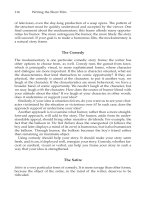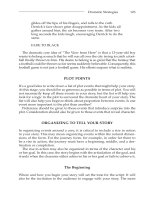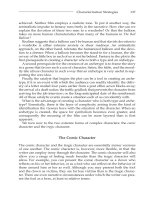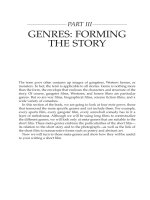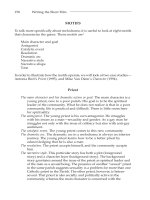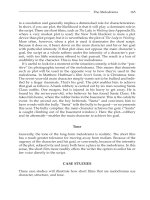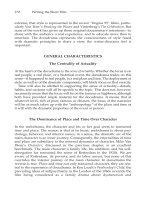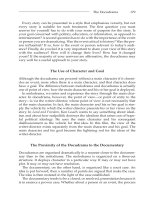Tài liệu Writing the short film 3th - Part 35 docx
Bạn đang xem bản rút gọn của tài liệu. Xem và tải ngay bản đầy đủ của tài liệu tại đây (119.61 KB, 7 trang )
the narrative. Metaphor, parable, allegory, in short, a more literary approach
to narrative is closer to a poetic approach, as opposed to the more realistic
approach found in the North American examples mentioned earlier.
THE IMPORTANCE OF THE SHORT FILM
The short film is crucial, not simply as a format suitable for portfolio devel-
opment. It is important for three enduring reasons: its proximity to other arts,
its cost, and its enhanced capacity for the voice of the writer and the director.
First, we will address the proximity of the short film to the other arts.
Unlike the feature film, in the United States the short film has strong link-
ages to noncommercial arts—the short story, the poem, the painting, the
photograph. Consequently, in both form and content, the short film is adap-
tive to a broader band of creative goals. The short film can address a moment
as the photograph does; a mood, as the poem does; or a deep, reflective
observation, as the short story so often has. The form consequently is far
freer in its creative parameters than is the long film.
A second and obvious consideration for making the short film is its cost.
No “stars” are required, and given the noncommercial nature of the short
film, locations and extras can be kept minimal to suit the story and the
budget of the filmmaker. Not mentioned, but equally important, is format
flexibility—a choice of 16mm, or video in various formats from beta SP to
digital to half-inch. All are used for the shorts. Budgetary considerations
may dictate the recording format, but improvements in transfers and print-
ing suggest that the exhibition format for the short film is also flexible.
Voice continues to be a critical element. Whether the filmmaker chooses
to use a genre that highlights voice (the fable, the satire, the docudrama,
the experimental narrative) or a more traditional melodrama or situation
comedy where voice is more masked, the more natural fit of the short film
to metaphor implies the greater potential of the short film for a stronger
sense of voice.
In addition, short films have been the starting point for significant film-
makers. John Schlesinger (Midnight Cowboy) began with Terminus. Roman
Polanski (The Pianist) began with Two Men and a Wardrobe. George Lucas
(Star Wars) began with THX1138. Each of these films experiments with form
and content, using a powerful voice that ultimately reached large audiences
and that thematically links the filmmakers’ later work to those short films.
THE PARALLELS IN DOCUMENTARY
The documentary shares with the short film its noncommercial history.
Consequently, each uses a broader band of actual and potential material. In
228 Writing the Short Film
Ch17.qxd 9/27/04 6:12 PM Page 228
part it also characterizes each as a less expensive and thus more available
form of expression. The two forms also share an important goal: the deep
desire to say something, to affect their audience. That conviction to affect the
audience is enabled by the relationship each form has to voice.
As mentioned earlier, the link of the short film to metaphor and to fable
enhances voice. In the case of the documentary, however, it is its unique
structure as well as the fact that it looks real that lends gravitas to the enter-
prise It’s about real people and real events, so the intention of the filmmaker
is to portray a real world as opposed to an imagined world. And as a result,
the documentary seems more important.
Turning to the structure of the documentary, its difference is almost imme-
diately apparent. The documentary looks like a case upon which its maker
has taken a decisive point of view. Think of it as the presentation of a social,
political, or economic problem. Implied in the voice of the filmmaker is what
he or she thinks is the desired solution. Every sequence makes another point
about the problem. The key is to emotionalize that problem through our rela-
tionship with a character or characters victimized by it. Few dramatic shorts
unfold in this way. Either character is a vehicle for voice (the fable) or the
vehicle for our identification (melodrama). We will have something of a jour-
ney as we follow the dramatic arc of the narrative. Unlike the documentary,
however, the structure is not driven by the need to make a case.
Finally, the documentary, because of its relatively low cost, has been a cen-
ter of innovation. In style, in sound, in its relentless attachment to “real
lives,” the documentary has been far more interested in innovation than its
more commercial counterpart. Here too, the parallels between the documen-
tary and the short film are striking.
THE PARALLELS IN EXPERIMENTAL FILM AND VIDEO
The parallels between the short film and the experimental film and video are
even more striking. As in the case of the documentary, the experimental film
or video offers cost advantages over the dramatic narrative. In addition, the
history of experimental film and video has been marked by a willingness to
take creative risks—a quality that affiliates these forms with innovation. The
experimental film and video forms are, as a result, as much a center for
invention as the documentary.
Because experimental film and video put a greater emphasis on form or
style than content, one can frame the genre as using style and content in a
dialectical fashion or simply to see the form obsessed solely with style. The
consequences are as follows:
1. A form in which premise, character, and plot are highly simplified
2. A form in which voice derives from the primacy of style over content
The Opportunity for Renewal 229
Ch17.qxd 9/27/04 6:12 PM Page 229
3. A form in which resolution or the result of the use of a plot is
supplanted by an open-endedness
4. An embrace of metaphor
Do these qualities have their analogue in the short film? To a certain
extent, they do. Short films rely on simplicity in characterization and the
deployment of plot. They tend to embrace metaphor. And short films also
tend to deploy a powerful voice—which leaves us with the degree of style
employed in the short film.
Although the experimental film and video embrace style as the central
quality of the genre, the short film varies in the degree of that embrace.
Although it is true that style is very important in the short film, it needn’t be
the exclusive defining characteristic that it is in the experimental genres.
Style will be less important should the filmmaker opt for a melodrama, but
it will become more important if the filmmaker opts for a fable or a docud-
rama or indeed an experimental narrative.
Nevertheless, the parallels between the experimental film and video and
the short film remain striking.
THE SHORT SHORT FILM—THE COMMERCIAL
The obvious characteristic about the commercial is how little time there is to tell
a story. Nevertheless, there is character and plot in many 30-, 60-, or 90-second
commercials. Several characteristics of these have had considerable influence
on the short film. Foremost of these characteristics is that the commercial needs
to find a visual solution to character and to plot. In addition, the style must be
strong but simple, and it has to observe the economy of the narrative.
Another influence that devolves from commercials is the use of humor. Of
course, humor is widely used in every film narrative form but again, the
commercial doesn’t have the time to build character and plot. So the humor
must be presented in an exaggerated form. A man finds out he has lost his
job as his boss on the elevator offers it to an “eager” and “younger” person.
All this happens on the trip up to his office.
Another notable characteristic of the short short film is surprise—a toddler
wearing the smock and stethoscope of a physician, the use of an animal to
comment on human behavior, and so on. Surprise and exaggeration are both
qualities of the commercial that have increasingly migrated into the short film.
THE NONLINEAR FILM
Another directional influence on the short film is the nonlinear film. The non-
linear feature film that I refer to takes two forms: the structural nonlinear film,
230 Writing the Short Film
Ch17.qxd 9/27/04 6:12 PM Page 230
such as Anderson’s Magnolia and Egoyan’s Exotica; or the pseudo nonlinear
film, such as Stone’s Natural Born Killers. The latter is in fact a loose narrative
that employs the MTV style to shape individual scenes. The latter also has a
more clearly linear shape in that there is a resolution of sorts.
The nonlinear film is marked by a number of characteristics. From the
point of view of resolution, there is none. The form is totally open-ended.
There are multiple main characters but they don’t share a goal or a dilemma.
There may or may not be a plot. Because the characters don’t have apparent
goals, there is nothing for the plot to work against and so plot in the nonlin-
ear film is background, no more important than dialogue or another infor-
mation track.
Two characteristics of the nonlinear film particularly commend them-
selves to the purposes of the short film. The first is the importance of voice
to pull the film into a coherent experience. The second is the urgency with
which individual scenes need to play out. They need to do so urgently
because the usual sources of identification and energ—the main character
and the vigorous pursuit of a goal—are absent in the nonlinear film.
Consequently, the nonlinear film needs to rely on sharper conflict between
characters and greater energy in the dialogue.
It may even be useful to think of the nonlinear film as a series of short
films about the individual characters who inhabit the narrative. What pulls
the stories together may be the voice of the filmmaker or it may be a
dilemma the characters share. (The half-dozen characters of the Sprecher sis-
ters’ 13 Conversations About One Thing, all find themselves living in New
York. They share location but differ in their philosophies of living. How fate
and the city interplay to challenge those philosophies is the core of each
character’s story.)
THE DIGITAL VIDEO MOVEMENT
The technology advance of digital video offers a new opportunity for mak-
ers of the short film. Essentially, the technology will not contribute directly
to the writing of a short film, but it will enable the writer-filmmaker to view
the writing process as more malleable.
To be specific, the fact that the writer can use digital video—an inexpen-
sive recording format—to work with actors and to try out scenes, implies
that such work, whether improvisational or scripted, can enhance the actual
script. In other words, the writing process can embrace what may have been
a discreet part of the pre-production process—casting, rehearsal—and a
more liberal attitude to what will constitute a scene or sequence as it even-
tually appears in the final form of the short film.
Digital video allows for experimental as well as experiential components
that were simply too expensive to imagine in 16mm, for example. In that
The Opportunity for Renewal 231
Ch17.qxd 9/27/04 6:12 PM Page 231
sense, digital video can alter what the writer considers the writing phase of
the production. It also opens the short film to a much larger constituency,
again because of the lower expense. This democratization can only benefit
the short film as a form as well as broaden its aesthetic parameters. There is
little question that the digital video revolution is already changing the
nature of short films.
NEW DIRECTIONS
Change is all around us. The object of this chapter has been to address the
reasons for and influences on the short film in a period of technological and
media change. Our goal has been to encourage the filmmaker to embrace
that change, and renew this form—the short film. That renewal is the oppor-
tunity you face today.
232 Writing the Short Film
Ch17.qxd 9/27/04 6:12 PM Page 232
